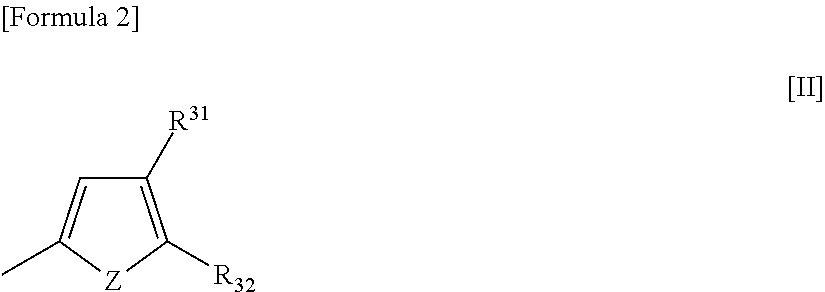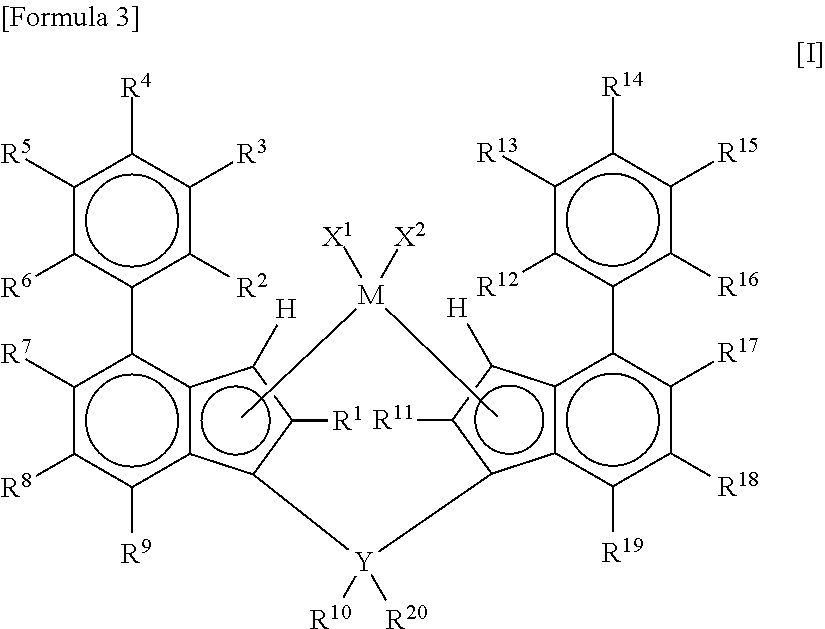Metallocene complex and polymerization method of olefin
a technology of olefin and complex, which is applied in the direction of catalyst activation/preparation, chemical/physical processes, group 4/14 element organic compounds, etc., can solve the problems of deterioration of anti-blocking properties, adverse effects of odor or taste, and deficiency of impact resistan
- Summary
- Abstract
- Description
- Claims
- Application Information
AI Technical Summary
Problems solved by technology
Method used
Image
Examples
example 1
Metallocene Complex A
Synthesis of dimethylsilylenebis(2-(2-(5-methylfuryl))-4-phenyl-5-methylindenyl)zirconium dichloride
(1-1) Synthesis of 4-phenyl-5-methylindene
phenylboronic acid (8.3 g, 68 mmol) was dissolved in ethylene glycol dimethylether (DME, 100 mL), and aqueous solution (100 mL) of cesium carbonate (30 g), 4-bromo-5-methylindene (10 g, 48 mmol), tetrakis(triphenylphosphine)palladium (3.0 g, 2.6 mmol) were sequentially added. Solution was reacted for 55 hours while heating under reflux, then, reaction solution was added into water (200 mL), and extracted with diisopropylether. Organic layer was washed with 1N hydrochloric acid and saturated aqueous solution of sodium chloride, then was dried over sodium sulfate, and solvent was distilled off under reduced pressure to obtain the crude product. This was purified by silica-gel column chromatography (Silica-gel 60: produced by Kanto Chemical Co., Inc, hexane) to obtain 4-phenyl-5-methylindene (8.5 g, yield: 86%) as colorless l...
example 2
Metallocene Complex B
Synthesis of dimethylsilylenebis(2-(2-(5-methylfuryl))-4-(4-t-butylphenyl)-5-methylindenyl)zirconium dichloride
(2-1) Synthesis of 4-(4-t-butylphenyl)-5-methylindene
4-t-butylphenylboronic acid (25 g, 0.14 mol) was dissolved in DME (250 mL), and aqueous solution (120 mL) of potassium carbonate (60 g), 4-bromo-5-methylindene (25 g, 0.11 mol), tetrakis(triphenylphosphine)palladium (5 g, 4.3 mmol) were sequentially added. Solution was reacted for 30 hours while heating under reflux, then, reaction solution was added to water (300 mL), and extracted with diisopropyl ether. Organic layer was washed with 1N hydrochloric acid, saturated aqueous solution of sodium chloride, then, was dried over sodium sulfate, and solvent was distilled off under reduced pressure to obtain the crude product.
This was purified by silica-gel column chromatography (Silica-gel 60: produced by Kanto Chemical Co., Inc, hexane) to obtain 4-(4-t-butylphenyl)-5-methylindene (24.4 g, yield: 82%) as c...
example 3
Metallocene Complex C
Synthesis of dimethylsilylenebis(2-(2-(5-methylfuryl))-4-(3-t-butylphenyl)-5-methylindenyl)zirconium dichloride
(3-1) Synthesis of 4-(3-t-butylphenyl)-5-methylindene
3-t-butylphenylboronic acid (10 g, 56.2 mmol) was dissolved in dimethoxyethane (150 mL), and aqueous solution (100 mL) of cesium carbonate (24.3 g, 74.6 mmol), 4-bromo-5-methylindene (7.8 g, 37.3 mmol), tetrakis(triphenylphosphine)palladium (1.7 g) were sequentially added. After solution was reacted for 26 hours while heating under reflux, reaction solution was poured into 1N hydrochloric acid-ice water, and extracted with diethyl ether after stirring. Organic layer was washed with saturated aqueous solution of sodium chloride, and dried over magnesium sulfate, then solvent was distilled off under reduced pressure to obtain the crude product.
This was purified by silica-gel column chromatography to obtain the desired 4-(3-t-butylphenyl)-5-methylindene (7.1 g, yield: 73%).
(3-2) Synthesis of 2-bromo-4-(3...
PUM
| Property | Measurement | Unit |
|---|---|---|
| Percent by mass | aaaaa | aaaaa |
| Percent by mass | aaaaa | aaaaa |
| Percent by mass | aaaaa | aaaaa |
Abstract
Description
Claims
Application Information
 Login to View More
Login to View More - R&D
- Intellectual Property
- Life Sciences
- Materials
- Tech Scout
- Unparalleled Data Quality
- Higher Quality Content
- 60% Fewer Hallucinations
Browse by: Latest US Patents, China's latest patents, Technical Efficacy Thesaurus, Application Domain, Technology Topic, Popular Technical Reports.
© 2025 PatSnap. All rights reserved.Legal|Privacy policy|Modern Slavery Act Transparency Statement|Sitemap|About US| Contact US: help@patsnap.com



